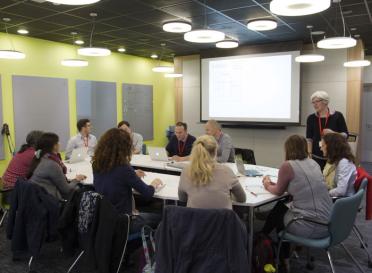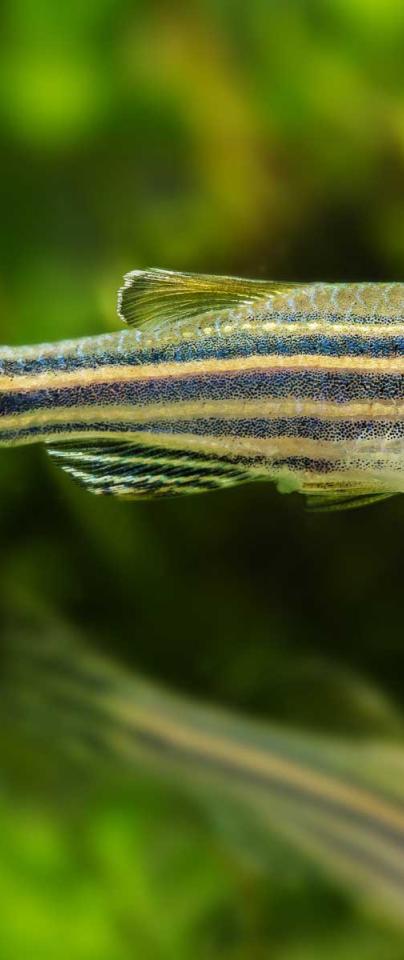Fostering symbiosis in the biosciences through multiscale modelling
Bridging bench-based biology with mathematics and computer sciences.
Multiscale modelling of host-microbe interactions requires interdisciplinary working akin to the mutual symbiosis of the very relationships we are trying to model. Bridging bench-based biology with mathematics and computer sciences, across diverse disciplines and institutes, this is exactly what the “Multiscale analysis of host-microbe interactions in plants, animals & humans” workshop, organised through the BBSRC UK Multiscale Biology Network, and hosted at Earlham Institute, aimed to achieve.
Many host-microbe interactions are mutually beneficial, and though we tend to think of organisms functioning as separate entities, it most often is not that simple. In the natural world, it’s about the and, not the or.
Similarly, according to Tamás Korcsmáros, “in the modern era of biosciences it’s about how different disciplines can work together in order to investigate how organisms interact on multiple scales.”
Therefore, the “Multiscale analysis of host-microbe interactions in plants, animals & humans” workshop was held at Earlham Institute, organised by Tamás Korcsmáros and Aidan Budd of EI, along with Richard Morris of the John Innes Centre, with the support of Markus Owen of the University of Nottingham, chair of the UK Multiscale Biology Network.
Before we can begin to understand many of the organisms that we study, it’s important that we understand the interactions between them, too.
For a long time, model organisms have been just that: single species representing a group of organisms, from which we extrapolate our findings to others; with plants it has been Arabidopsis, with mammals is has been mice, for fish it has been Danio rerio.
However, as much as these model organisms have shed light on important mechanisms on both a genetic and phenotypic level, they don’t come close to describing the unique interactions with other organisms that take place on and around them.
As much as we know that ecosystems rely on a balance of species that we can observe with our plain eye, microorganisms that live in and around us, everywhere, from plant roots to the human gut, can also make or break our survival.
Up to 97% of plants rely on fungi in the soil just in order to obtain enough nutrients. Even with those fungi, if it weren’t for bacteria living in the soil, then there certainly wouldn’t be enough nitrogen to go around. Indeed, with ten times more bacterial cells present in a human being than we have to call our own, the diversity of interaction within the stomach contents of each individual person is staggering.
But how do we begin to explore these complex relationships, and how do these interactions manifest themselves? How do the complex networks of microbes communicate and interact with their hosts, and vice versa? How do pathogens communicate with our cells and other microbes to effect diseases?
This is where multiscale modelling of host-microbe interactions comes in.

Clearly, on a planet boasting over ten million species, we cannot possibly hope to investigate and understand them all in laboratory conditions.
However, with the advent of modern analytical methods, including an abundance of, and more affordable access to, genome sequencing and supercomputing technologies, we can combine our approach to apply mathematics and bioinformatics to how we investigate the complex interactions within and between living systems.
We now have the tools and resources to study such interactions not just on an organismal level, but at the genetic level, the protein level, and a whole set of other levels besides.
However, it’s one thing having the tools and the resources to perform such analyses, but another thing entirely building the research communities and teams to be able to tackle them on multiple scales.
This is precisely what the recent “Multiscale analysis of host-microbe interactions in plants, animals & humans” workshop focused on achieving. Aiming to increase collaboration on a UK-wide scale, the event attracted 70 researchers from 22 institutes, including an equal mixture of laboratory-based and computer scientists.
Earlham Institute was a fitting location to host such an important workshop, especially considering the importance placed on open, collaborative work and community engagement, as well as having expertise in areas of host-microbe interactions, mathematical modelling and bioinformatics, particularly pertaining to host-microbe interactions in the human gut.


For a long time, model organisms have been just that: single species representing a group of organisms, from which we extrapolate our findings to others; with plants it has been Arabidopsis, with mammals is has been mice, for fish it has been Danio rerio.

Credit: Kuttelvaserova
Stuchelova/Shutterstock.com
The workshop aimed not only to encourage participant-driven discussion and education around multiscale modelling of host-microbe interactions in different contexts, but also to spark momentum for the development of new projects, with advice from experts on how best to fund these collaborations going forwards.
Following keynote talks, the workshop then fit in several parallel sessions which covered some of the methodology behind multiscale modelling. Topics spanned a broad range, including multi-omics approaches, metabolomics, host-microbe networks, epidemiological modelling and modelling bacterial growth.
However, the main thrust of the workshop was to encourage and inspire new collaborations, and thus the longest time spent during the workshop was on group discussions designed for exactly that, which focused on a range of important host-microbe relationships.
Four groups covered important topics including biofilm formation, antimicrobial resistance and the interactions between plants and microbes in the rhizosphere. Stressing the various levels on which multiscale modelling can be applied, the groups covered a wide range of methodological approaches, including transcriptomics, metabolomics, imaging, multi-omics and mathematical modelling.
However, as important as it is to generate collaborations and possible opportunities to work together on such projects, funding is essential. Therefore, each project group presented their findings to an expert panel, who were able to give important feedback on how best to go about getting such ideas funded.
Several participants contacted the organisers after the event to say that it was extremely useful for meeting new potential collaborators and for generating ideas for potentially novel collaborations.
Furthermore, it looks as though at least two of the project groups who took part in the workshop are planning on taking forward the plans they developed during the workshop to put together proposals for grants based on them.
According to Aidan Budd, who co-organised the event, "it was great how the meeting built an effective dialogue between bench scientists and mathematicians/computer specialists.
“It can be really hard to make this happen, so we were really pleased to see so many productive discussions happening between people of such different backgrounds.”